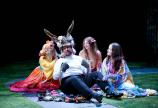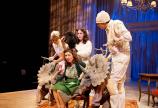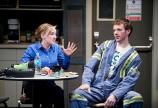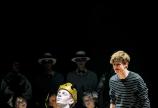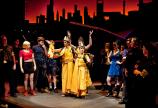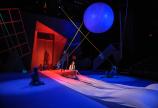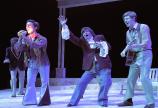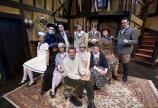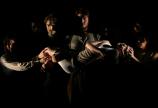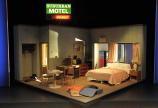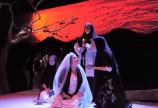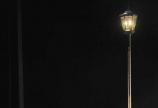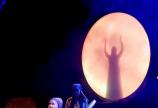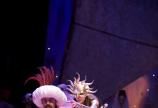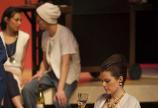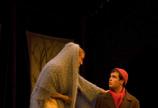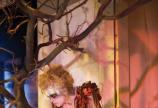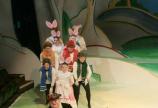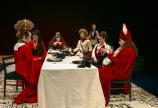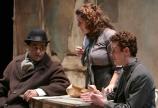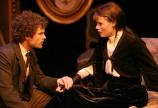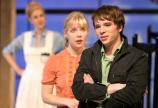The history of the Phoenix Theatre
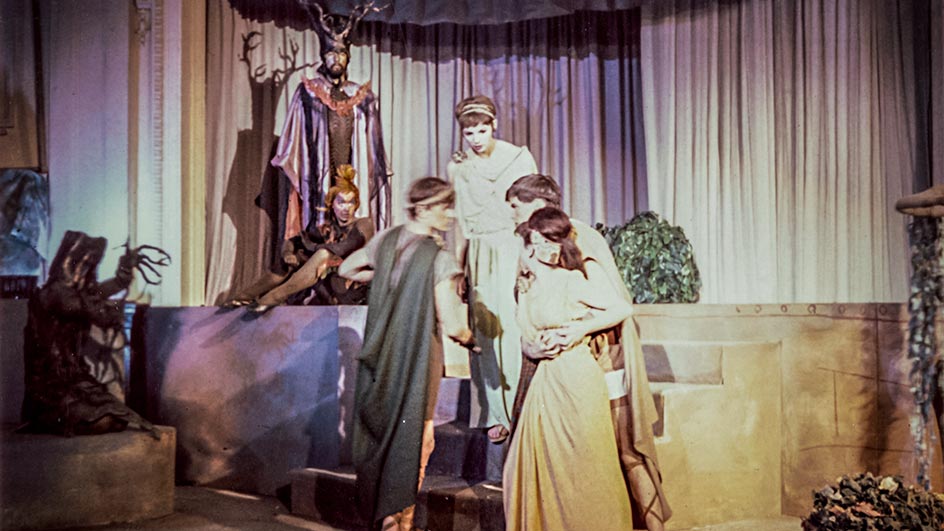
For an interactive historical timeline, including 50 years of productions, faculty and selected alumni, visit our special 50th Anniversary website.
Like the story of the mythical Phoenix that is the namesake of our building, the history of the Department of Theatre is one of continual rejuvenation, growth, and inspiration.
1963: A new university
Even before there was a Department of Theatre, theatrical productions were an important part of the fledgling Victoria College, an affiliate of McGill University and the earliest iteration of the University of Victoria. Located on the Lansdowne Campus (now the home of Camosun College), Victoria College hosted the Players’ Club, which actively produced plays in the Young Building Auditorium. Professor Roger Bishop, the Chair of the Department of English, directed many of these plays.
In 1963, Victoria College became the University of Victoria, an autonomous, full degree-granting institution. Its increasing size necessitated a new home, so the university began to transfer courses to buildings located on the new Gordon Head campus.
Right from its first year, the University of Victoria offered a course in Theatre through the Faculty of Arts and Sciences. By the next year, one course grew into four. These courses were offered by the English department. Roger Bishop approached Carl Hare, a young English professor with an interest in theatre who would later become the Director of Theatre, and shared his idea of creating a fully realized theatre program. The initial plan was that Hare would teach many of the theatre classes as well as direct and perform in some of the early productions.
1963 - 1965: The Phoenix rises
Charged with the development of a theatre curriculum and the promise of two army huts, Carl Hare began transforming the small, square buildings on the Gordon Head campus that had been erected as a military base into the first Phoenix Theatre. With only $12,500 – much of it fundraised from the Victoria College Players Club – he mobilized volunteers, faculty, and students to start work on what would become a tiny eighty-seat theatre.
“You have to realize that in those days, UVic was just an army camp,” says Hare. “There were no buildings, everything was moved into army huts – the bookstore, the faculty club. That first year, we taught at Victoria College while the huts were being renovated. We didn’t get in till January of 1963.”
The Phoenix Theatre was fashioned by erecting a concrete building to fit between two long huts. As well as the department’s performance space, the resulting building served as a multi-purpose classroom. The department’s offices and scene shops operated out of one of the huts while classes were held in another. Students constantly had to run back and forth between them – from “L” Hut to “M” Hut to “R” Hut, crossing over McKenzie Avenue many times a day.
The theatre space contained a simple stage and a control booth, but no wing space or fly tower. Nevertheless, it was – and still is – regarded fondly as a creative venue. The name – the Phoenix Theatre – was a fitting moniker for a building that rose from the remnants of the old military hospital, morgue, and chapel.
One of the students who helped to build this Phoenix Theatre was Michael Whitfield, now an internationally acclaimed lighting designer with a thirty-five-year career with the Stratford Festival and other prestigious theatres around the world. Whitfield was present in the summer of 1964 when the Department of English began producing plays through a “town and gown” initiative called the Campus Players, which brought students, faculty and local actors together to stage productions. To celebrate the quadrennial of Shakespeare’s birth, they presented Shakespeare ’64, a festival featuring productions of A Midsummer Night’s Dream, The Alchemist and Richard III at the Young Building Auditorium on Lansdowne campus.
“The Campus Players were remarkable because you’d frequently be working alongside your professors in a completely different environment,” says Whitfield, who returned to UVic to teach as a sessional instructor since retiring from Stratford.
Whitfield’s memory of the collaborate spirit that defined the early days of the Phoenix is shared by Hare:
“The Campus Players was the backbone of campus theatre. You had the faculty wives – who did construction and costumes, cleaned the lobby and the dressing rooms, organized receptions and cast parties, sold tickets and were really essential to the first stages of the progress toward a department – plus the faculty themselves and the students. Everyone across the university was assisting with this, literally building the theatre. Didn’t matter what department they were in, they were making it their own.”
By the summer of 1965, the newly opened Phoenix Theatre hosted a Renaissance Festival, featuring Twelfth Night and A Man For All Seasons.
1969: A faculty is born
With the new theatre space created and several production successes in hand, the Department of English expanded its number of theatre courses and created a Division of Theatre in 1965. Students could now earn a BA with a Major in Theatre.
As early as April of 1964, the University Senate began to assess all Fine Arts offerings on campus. A Curriculum Committee completed a comprehensive study by December, which recommended the establishment of a distinctive School of Fine Arts for the study of the theory, history, and practice of the arts. The UVic Senate formally tabled this recommendation in April of 1965.
Beginning in the fall of 1967, UVic had one of Canada’s first integrated Schools of Fine Arts, with Divisions in Theatre, Music, and Art and Art History. Instead of acquiring a BA, the students earned a Bachelor of Fine Arts.
Only two years later, in 1969, the School of Fine Arts developed into the Faculty of Fine Arts, and the divisions became the Departments of Theatre, Art History, Studio Visual Arts, and Music.
In the Department of Theatre, specializations in Acting, Design, Directing, and Developmental Drama (later called Theatre-in-Education and now referred to as Applied Theatre) were offered along with Masters level programs. Ralph Allen, who arrived to teach in 1968, was named the department’s first full Chair and over the next few years, he would recruit many new faculty and staff who would have a lasting impact on the department. Among these early recruits were John Krich, who joined the department to teach acting in 1969 and introduced many new initiatives before retiring in 2002, and Harvey Miller who arrived in 1970 and taught directing until 2002.
1969 - 1980: The Phoenix and the community
The new Faculty of Fine Arts quickly established itself as a leader in the local arts community by launching Victoria Fair, an adventurous, Victoria-wide cultural event that was rich with theatre, music, lectures, and art exhibitions. Held each summer from 1969 to 1971, the festival centered around three plays mounted by the Department of Theatre that ran in repertoire, usually at the McPherson Playhouse in downtown Victoria. Victoria Fairfeatured professional theatre artists from across Canada and the US, including Christopher Newton (later the Artistic Director at Shaw Festival), Marti Maraden (later the Co-Artistic Director at Stratford and Artistic Director at the National Arts Centre) and Neil Munro (later a Resident Director at Shaw). These artists worked closely with UVic faculty, staff, and students, as well as theatre artists from the Victoria community. Other local arts organizations also participated, and Victoria Fair included concerts by the Victoria Conservatory of Music and children’s theatre presentations by the Bastion Theatre Co. Victoria Fair also featured play-related lectures, and numerous concerts and recitals, presented on campus throughout the summer. The 1970 fair saw the world premieres of two commissioned works and special exhibitions at the university's Maltwood Museum.
“I remember the Victoria Fair as an incredible cross-cultural endeavour between UVic and Victoria’s arts community that would produce the best in world-class theatre here in Victoria,” says John Krich.
Victoria Fair was also an early indicator of how closely the Department of Theatre would influence and become intertwined with Victoria’s local theatre community.
This initiative to reach out to the community was also extended to high school students from across BC. Over various summers, as early as 1966 and running until 1983, the Department of Theatre hosted Senior Secondary Summer Theatre Workshops (known as the SSSTW). Each summer a selected group of high school students from across BC and other provinces enrolled in theatre studies that culminated in a fully mounted production on the Phoenix stage under the guidance of a guest director. Many of these high school students elected to continue their theatre studies at the University of Victoria.
The growing department would receive nation-wide recognition when it participated in the national Dominion Drama Festivals, including accolades for their 1971 festival presentation of Justice Not Revenge in Ottawa and their 1973 presentation of The Threepenny Opera in St. John’s, Newfoundland.
Spearheaded by Professor John Krich – and running for twenty-six years – the Department of Theatre began producing Phoenix Summer Theatre (PST) in 1972. PST was designed to provide an intensive, realistic repertory experience for theatre students outside the school year. It was supported by the UVic’s Summer Session office as well as a grant from the federal Opportunities For Youth program, which paid the students around fifty dollars a week. Throughout its existence, a wide variety of work, from plays and musicals to dance and spoken word was produced. In 1985, after the new Phoenix Building and the Faculty Club (now called the University Club) were constructed, the two groups began working collaboratively to offer Barbeque Theatre, an outdoor dinner theatre presentation. Many memorable performances were staged here using the trees, shrubbery and even the actual pond that surrounds the Club’s patio as part of the scenery for plays like Shakespeare’s As You Like It; Agatha Christie’s Murder On The Nile; Noel Coward’s Hayfever; and a spectacular production of J.M. Barrie’s Peter Pan (that was filmed and broadcast on CHEK TV). Peter Pan featured actors magically flying through the trees and a mechanical crocodile swimming in the pond!
During this productive period, many influential faculty members and staff arrived who would shape the future of the department. In 1971, the renowned Theatre-in-Education pioneer Barbara McIntyre came to UVic and was named the Department Chair in 1972 after Ralph Allen’s departure. In the same year, lighting designer Giles Hogya and movement instructor Kazimierz Piesowocki joined the department. Hogya was the Chair of the Department from 1995 to1998 and served as Dean of the Faculty of Fine Arts from 1998 to 2007. Piesowocki influenced generations of theatre students over his twenty-five years at the Phoenix and often returned as a guest artist after he retired in 1998. Staff member Bindon Kinghorn arrived in 1973 to be the chief carpenter and as well as teaching stage management and directing plays, and would become the Theatre Manager for many years before retiring in 2013. William D. West, the noted local artist, became a design professor in 1974 and stayed until retiring in 1985. West had already contributed to UVic’s new campus in 1965 when he created the mobile sculpture for the north stairwell of the Clearihue Building. Later, for the university’s 15th anniversary, he was asked to design UVic’s official flag. At the Phoenix he also designed and created the Coast Salish basket weave mural at the entrance of the current Chief Dan George Theatre. Linda Hardy, the department’s current and much-loved voice instructor, acting professor, and director, arrived at the department in 1975.
With an increased faculty and growing student body all working to produce a full season of shows during the school year, plus running a repertory company during the summer, the department was expanding at a prodigious rate and it quickly outgrew its home in the old military huts.
1981: Breaking ground on a new Phoenix
At the close of the 1970s a new wave of excitement swept through the Department of Theatre as it was announced that, with the support of President Howard Petch, the UVic Board of Governors, and the Universities Council of BC, a new theatre facility would be constructed on campus. A site on the west side of campus was chosen and a committee was struck to research examples of other university theatre facilities. Throughout the design period of the new building, theatre faculty, staff and students were engaged in the planning process, with particular input from Carl Hare and design professor William West.
Designed by architects Peterson & Lester, the new Phoenix Building featured three state-of-the-art performance spaces. It also consolidated all the department’s facilities under one roof so students would no longer spend their days dashing from hut to hut.
Its three performance spaces were named to honour the department’s history and the community: the Roger Bishop proscenium arch theatre was named in recognition of Professor Bishop’s ardent championing of theatre and the department during its early years; the Chief Dan George thrust theatre was named in the memory of one of Canada’s most distinguished First Nations actors who was born on the West Coast; and the Barbara McIntyre studio space, named to honour Professor McIntyre’s service as the department’s first female chair from 1972 to 1981. The building was also equipped with all the latest gear, including a computerized stage lighting system. The Phoenix easily boasted being one of the finest academic theatre complexes in the country, and remains so today.
Although the building was not completely finished at the end of the fall term in 1981, the Department of Theatre decamped from Q-Hut to its new home over the Christmas holidays. In January, a new semester and a whole new era of Phoenix Theatre would begin at UVic. Faculty, staff, and some students boxed up every costume, prop, and set piece, and, as soon as classes ended, the entire contents of the old buildings were fitted into a convoy of moving trucks that made their way around Ring Road to their new home. With classes – and work on the next play – resuming in January, all hands pitched in to unpack thousands of costumes, install and set up classroom furniture, and even build a temporary mezzanine level for an over abundance of props.
1982 - 1998: New building brings new opportunities
The Department of Theatre flourished in its new surroundings and with the new Phoenix Building came opportunities to profile UVic’s beautiful theatre facilities on a national level. The first spring after the official opening in 1982, the department welcomed the International Children’s Theatre Festival. Theatre companies from around the world presented a variety of dance, music, puppetry, and theatrical productions over four days on the Phoenix stages.
A collaboration between the Department of Theatre and the Department of Writing in 1984 saw the launch of the Futurewrights. This program provided opportunities for theatre students to direct new plays by writing students in the Phoenix performance spaces. This initiative evolved over the years and was later called Phoenix Plays, then the Festival of Innovative New Drama Series, and finally the Studio Series.
In 1991, the Department of Theatre celebrated its 25th anniversary. Dubbed the Silver Phoenix Celebrations and organized with the immeasurable help of Katherine Edwards, the department’s long-time secretary, the reunion brought over 125 former students, graduates, faculty, and staff to the campus for a weekend in late August. Inside the building, the Phoenix was transformed into a museum of memories, featuring displays of costumes, props, scenery, photographs, programs, and other ephemera from the past. Over the weekend, former classmates, faculty, and staff reunited and reminisced at a dinner and dance, a brunch, a barbeque and an unforgettable game of croquet/mini golf that took participants across the old parking lot that is now occupied by the Visual Arts building.
That same year, several students (led by David McPherson and Ian Case) approached the faculty with an idea: the creation of an independent theatre company run by current students, for students, with the support of the department. The Student Alternative Theatre Company (SATCo) was born. Tim Sutherland coordinated the first season, which set the standard for years to come. Any short, one-act play, whether written by an established playwright or a current student, could be submitted for the consideration of the SATCo committee. Each week, student writers and/or directors, designers, and actors would develop, rehearse, and present their work for the department over short three-day runs. Many interesting projects came out of this independent experimental process, including the first-run of many plays (like Atomic Vaudeville’s Legoland) that would later be remounted at the Fringe Festivals or presented by other theatre companies. Many relationships forged during SATCo productions evolved in to small independent theatre companies after graduation, among them Theatre SKAM, ITSAZOO Productions, and SNAFU Dance Theatre. As the department celebrates its 50th anniversary in 2016, SATCo in turn celebrates twenty-five years of making theatre by students, for students.
In 1994, Theatre-in-Education professor Juliana Saxton and Faculty of Education professor Carole Miller (also the wife of directing professor Harvey Miller) worked together to host the first National Canadian Tertiary Drama Educators Symposium at Dunsmuir Lodge. The papers submitted to this symposium later were edited and published as Canadian Drama Education: The State of Our Art. This gathering laid the foundation for the second International Drama in Education Research Institute in 1997, which brought over 100 delegates from fourteen countries to UVic’s campus. To this day, the Department of Theatre’s Applied Theatre professors work collaboratively with the Faculty of Education professors to invite noted practitioners to the annual Summer Drama Institute for the benefit of students in both areas.
The Department of Theatre hosted the International Beckett Festival in May of 1996. Theatre companies and distinguished scholars from around the world came together to celebrate the life and work of the playwright, novelist, poet and theatre director Samuel Beckett. Over twenty academic papers were presented and twenty-one plays were performed by theatre groups, including the Goetheanum-Buhne from Switzerland, the Pantechnicon Theatre Co. from California, and the Jean Cocteau Repertory Co. from New York. A highlight of the festival was a special appearance by Fred Neumann, co-Artistic Director of the Mabou Mines Theatre Co. in New York, who was considered to be the pre-eminent interpreter of the works of Samuel Beckett. Neumann performed Worstward Ho, a work that Beckett himself had given to Neumann during their long professional relationship.
During this period, Carl Hare became the Department Chair from 1982-1984, before leaving to take a position in another university. Following his departure, Barbara McIntyre returned as Acting Chair until the renowned British theatre historian, Michael Booth, was selected as the new Chair during an international search. Over his ten years in the position, Booth was instrumental in working with long-time theatre history faculty member Alan Hughes to usher in a Theatre History PhD program..
As the 1990s came to a close, so did some long-time Phoenix traditions. After twenty-five years of incredible success, the Phoenix Summer Theatre program came to an end following the 1998 production of Nunsense.
1998 - 2015: Into a new millennium
The years around the new millennium saw the Department of Theatre’s faculty expand yet again. With Michael Booth retiring, Jennifer Wise, a respected scholar, was selected to teach theatre history. Internationally distinguished theatre designer Mary Kerr was hired to head up the department’s costume design area, and professional actor Jan Wood was first contracted as an Artist-in-Residence before later joining the faculty.
With Giles Hogya promoted from Department Chair to Dean of Fine Arts in 1998, the department struggled to fill this position until 2001, when Brian Richmond, a Canadian director and founder of the Persephone Theatre, was invited to become the new Chair. With new marketing materials in 2002 – including the bright red awning over the entrance – the department launched another enduring program, the Spotlight on Alumni. First introduced in 2003 with TJ Dawes’ The Slipknot, this program invited theatre graduates back to their Alma Mater to be part of the Phoenix Mainstage Season. Thus began over a decade of incredible performances that not only highlighted the success of theatre graduates, but in the process gave current students an opportunity to be mentored by professional artists. Continuing to this day, the Spotlight program has been expanded into a three-week Alumni Festival for the 50th anniversary season.
From 2005 to 2008, the Faculty of Fine Arts entered into a cultural exchange with the Universidad of Veracruzana in Xalapa, Mexico. Dean Giles Hogya, Theatre Manager Bindon Kinghorn, and several other Fine Arts faculty members travelled to Xalapa in 2006 to study Spanish and participate in the Drama Department there. In 2006, Mexican visual artist José Manuel Morelos Villegas designed the play posters for the 2006-2007 Phoenix season and Mexican director Martín Zapata came to Victoria to direct his play El insólito caso del señorMorton (The Unusual Case of Mr. Morton) in 2008.
In November 2009, the department participated in an interdisciplinary project with the Department of Physics and Astronomy during the International Year of Astronomy with the first staged reading of Moons of Jupiter, a new play by Professor Jennifer Wise about Galileo and his daughters. Another interdisciplinary project saw the department collaborate with the Department of Germanic Studies in 2011 on a cross-listed course that culminated in a staged reading of Woyzeck in German. The performance drew many audience members from both the university and the local German community.
To celebrate the 50th anniversary of the University of Victoria, UVic was the host of the 2013 Congress of the Humanities and Social Sciences. This huge campus-wide event included the annual Canadian Association for Theatre Research (CATR) Conference held here at the Phoenix Theatre. The conference saw the return of many alumni who are now working at universities and in various academic roles across Canada. During the conference, the CATR honoured Professor Juliana Saxton as well as Dr. Ann Saddlemyer, the founding president of the association who was a faculty member in the Department of English when Theatre courses at UVic were first offered.
In 2015, the Department of Theatre hosted the first national symposium on actor training, initiated by movement professor Conrad Alexandrowicz. Entitled “Actor Training in a Shifting World,” the symposium brought thirty-four acting instructors from post-secondary institutions across Canada to discuss the state of their field and to share ideas about the future of actor training in Canada.
During the last decade, the department has continued to grow and change. In 2006, the internationally respected English Applied Theatre practitioner, Warwick Dobson came to the department as the University Scholar in Applied Theatre. In 2008, Dobson succeeded Brian Richmond as the Department Chair. Other new faculty members included Fine Arts Dean and theatre historian Sarah Blackstone, movement professor Conrad Alexandrowicz, returning alumni Peter McGuire and Anthony Vickery, actor and director Fran Gebhard, and theatre and dance historian Allana Lindgren, who was named to the position of Department Chair in 2014. In 2015, the department’s Applied Theatre program expanded and gained an additional faculty member, Kirsten Sadeghi-Yekta.
During the past decade, the Thirty-five-year-old Phoenix Building has also undergone renovations and rejuvenations. With the replacement of the dimmer system, lighting instruments, and operating boards, new rigging, new house curtains, and an extensive replacement and upgrade of the theatre sound systems, this much loved facility maintains its state-of-the-art status.
1994 - Today: A global direction
In 1994, Law faculty member Bill Neilson proposed a cultural exchange between UVic and the prestigious Chulalongkorn University in Thailand. Linda Hardy was asked to be one of the first to participate in a faculty exchange, and in 1995 she worked with Chulalongkorn faculty to direct Shakespeare’s A Midsummer Nights’ Dream, translated into Thai and placed into a contemporary Thai setting.
This initiative helped lay the foundation for a new student-based relationship with the Bangkok University’s Performing Arts Department. Spearheaded by design professor Allan Stichbury in 2013, this global exchange program has seen six UVic theatre students travel to Bangkok to study design, production and management, or applied theatre for one term. The first Thai exchange student arrived to study at UVic in the spring of 2016.
In 2014, the Department of Theatre initiated its first field school program, organized by Applied Theatre professor Warwick Dobson. Led by PhD candidate Matthew Gusul as part of his applied theatre thesis research, thirteen theatre students traveled to Tamil Nadu and Pondicherr, India, to participate in a two-month project bringing together elders from the Tamaraikulam Elder’s Village and young students of the Isha Vidhya Matriculation School. Students worked with both groups to share stories and help develop an intergenerational theatre company.
These global initiatives have also lead to a rise in international students arriving for our undergraduate, and especially graduate programs, to be mentored by the world-class faculty at the Department of Theatre. With students arriving from the Philippines, Thailand, Nigeria, China, Australia, South Africa, Argentina, and the United States, this international scope of experiences has been a positive influence on the theatre research and practices for all Phoenix students.
As the Department of Theatre looks to its next fifty years, we are eager to continue to educate new generations of theatre artists, and to shape the landscape of theatre in our own community, across Canada, and the world.
